{{currentView.title}}
July 03, 2024
Africa File, July 3, 2024: Boko Haram Resurgence; JNIM Onslaught in Burkina Faso; al Shabaab Exploits AU Withdrawal
Data Cutoff: July 3, 2024, at 10 a.m.
To receive the Africa File via email, please subscribe here. Follow CTP on Twitter, LinkedIn, and Facebook.
The Africa File provides regular analysis and assessments of major developments regarding state and nonstate actors’ activities in Africa that undermine regional stability and threaten US personnel and interests.
Key Takeaways:
- Nigeria. Boko Haram almost certainly conducted its first suicide attack since 2020, highlighting its ongoing resurgence in northeastern Nigeria. Boko Haram has also strengthened its territorial control, finances, and manpower over the past year. The attack may aim to inspire surrendered or defected Boko Haram fighters to remobilize.
- Burkina Faso. Al Qaeda’s Sahelian affiliate Jama’at Nusrat al Islam wa al Muslimeen (JNIM) is carrying out increasingly deadly attacks on civilians across Burkina Faso, likely to consolidate its support zones. JNIM has increasingly targeted civilians since the current Burkinabe junta came into power and decided to militarize and mobilize civilians against JNIM. The rising toll of JNIM offensives is undermining support for the already-embattled Burkinabe junta, heightening the risk of a coup, which is preoccupying security forces and creating additional opportunities for insurgents.
- Somalia. The ongoing transition of military bases from African Union (AU) forces to Somali forces is creating opportunities for al Shabaab to exploit security gaps to attack AU and Somali forces. Al Shabaab recently conducted a suicide vehicle-borne improvised explosive device attack targeting one of these bases in central Somalia. The attack demonstrates both the threat to these bases and the growing security challenges the Somali Federal Government faces in central Somalia in 2024.
Assessments:
Nigeria
Boko Haram almost certainly conducted its first suicide attack since 2020, highlighting its ongoing resurgence in northeastern Nigeria. At least three female suicide bombers targeted a wedding, funeral, and hospital in coordinated attacks in Gwoza town, Borno state, on June 29.[1] The bombings killed at least 32 civilians.[2] No group has claimed the attack. The use of female suicide bombers suggests that the Boko Haram faction located in the Mandara Mountains, along the Nigeria-Cameroon border, was responsible. Boko Haram has used female suicide bombers whereas other groups, such as the regional IS affiliate, have not.[3] The attack is the first Boko Haram suicide attack since 2020.
Boko Haram has strengthened its territorial control, finances, and manpower over the past year. IS West Africa Province (ISWAP) launched an offensive against Boko Haram in 2021 that ultimately killed the long-time Boko Haram leader Abubakar Shekau.[4] Shekau’s death led Boko Haram—formally called Jama’at Ahl al Sunnah li al Dawa wa al Jihad—to fragment, leading thousands of militants to either surrender to government forces or defect to ISWAP in the months afterward.[5] However, factions of Shekau loyalists have remained resilient and consolidated in two remote enclaves: the stronger Lake Chad Basin faction and the weaker Mandara Mountains faction, the latter of which is likely responsible for the recent suicide bombing based on geographic proximity.[6]
Figure 1. Boko Haram Resurgent in Northeastern Nigeria
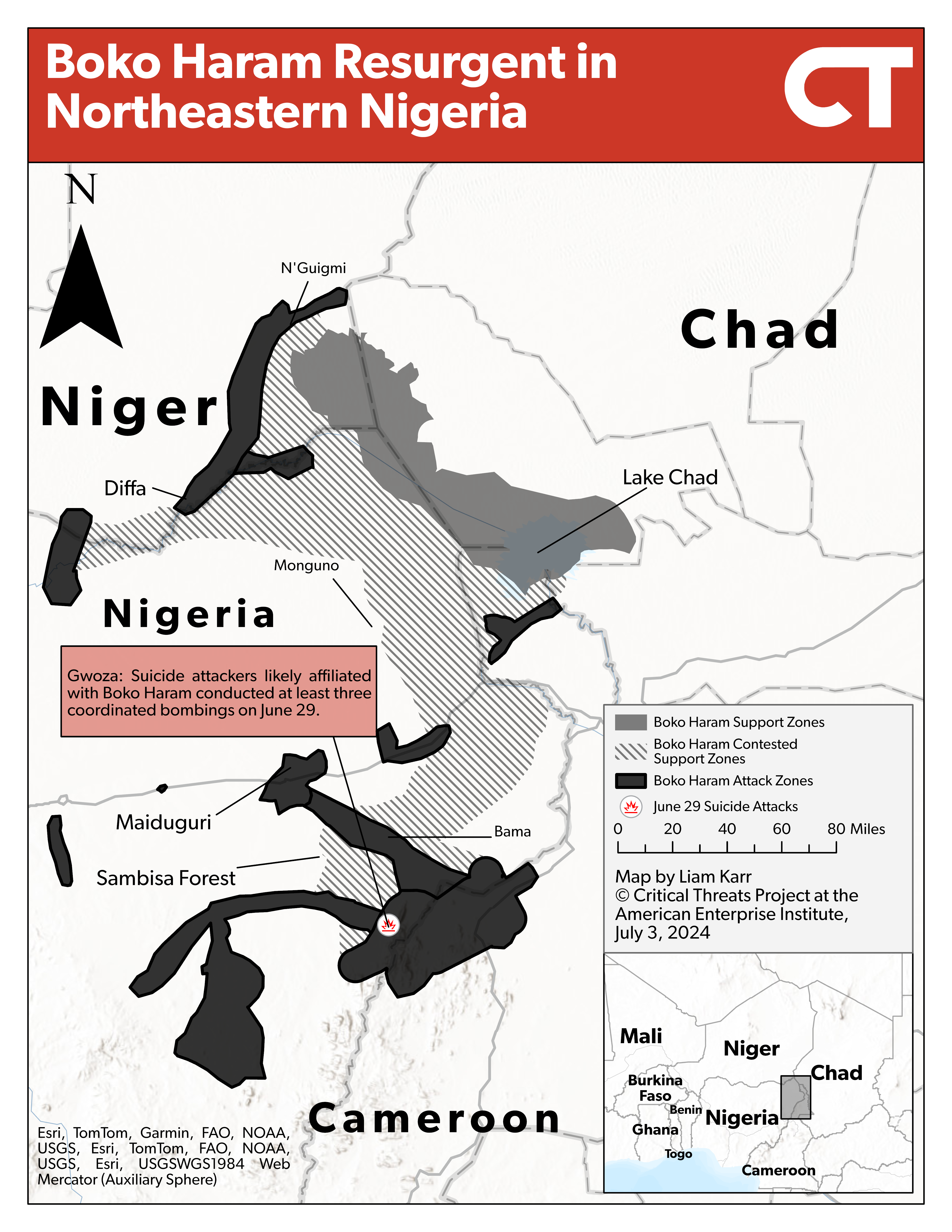
Source: Liam Karr.
The Lake Chad faction consolidated under a new leader in late 2022, Bakura Doro.[7] Bakura’s Lake Chad faction launched an offensive against ISWAP in 2023 and retook several islands that housed ISWAP armories and leadership headquarters.[8] This territorial gain gave Boko Haram control over the farmers, fishers, and herders ISWAP had been taxing, giving the group opportunities to boost its group’s financial resources.[9] Boko Haram’s resurgence also led hundreds of disgruntled ISWAP militants to defect to Boko Haram due to Boko Haram’s comparatively lighter rules, especially concerning looting civilians.[10] The UN estimates that this faction currently has approximately 1,000 fighters.[11]
The Mandara Mountains faction is weaker than the Lake Chad faction. The group and its leadership are subordinate to Bakura’s Lake Chad faction but still operate largely autonomously due to both factions’ topographically remote base areas.[12] The 500 to 1,000 fighters that make up the Mandara Mountains faction predominantly attack and loot civilians to sustain themselves and do not battle with ISWAP as frequently as the Lake Chad faction.[13] It is unclear what degree of command and control Bakura has over the Mandara faction and whether he could have ordered or facilitated the suicide bombings.
Boko Haram may be trying to inspire surrendered or defected Boko Haram fighters to remobilize. Between 2021 and 2023, several thousand Boko Haram members surrendered to authorities in Nigeria and Cameroon.[14] Most defectors left because the group was weaker following Shekau’s death. With Boko Haram regaining strength, some of them may be tempted to go back. Some defectors say they were better off under Boko Haram than in government-controlled areas.[15] The highly visible attack is a show of strength and appeal to these disgruntled ex–Boko Haram fighters, which would help both the Mandara Mountains and Lake Chad factions.
The Mandara Mountains faction may also be aiming to bolster its position by intimidating security forces and boosting morale. In 2023, a group of fighters threatened to increase suicide bombings in retaliation for Civilian Joint Task Force (CJTF) activity against the group.[16] The group had not attacked in this area of Nigeria since March but had faced growing security pressure from the CJTF in May.[17] Several groups of militants had also surrendered to government forces or defected to ISWAP over the same period, indicating low morale.
Burkina Faso
JNIM is carrying out increasingly deadly attacks on civilians across Burkina Faso, likely to consolidate its support zones. Al Qaeda’s Sahelian affiliate, Jama’at Nusrat al Islam wa al Muslimeen (JNIM), intensified its attacks in northwestern Burkina Faso, along the border with Mali, in June. JNIM killed 167 people on both sides of the border of Mali and Burkina Faso’s Boucle du Mouhoun province in June. This is nearly three times the number of people killed in the next deadliest month so far in 2024. An offensive in Burkina Faso’s Kossi province is driving this massive uptick. The group carried out nine attacks in the province in June and killed 146 people, making June its busiest and deadliest month of 2024. JNIM support zones near this area enable JNIM to conduct cross-border attacks close to multiple Malian district capitals; Djenne, San, and Tominian are roughly within 75 miles of this part of the border.
Figure 2. JNIM Escalates Attacks on Northwestern Burkinabe Border
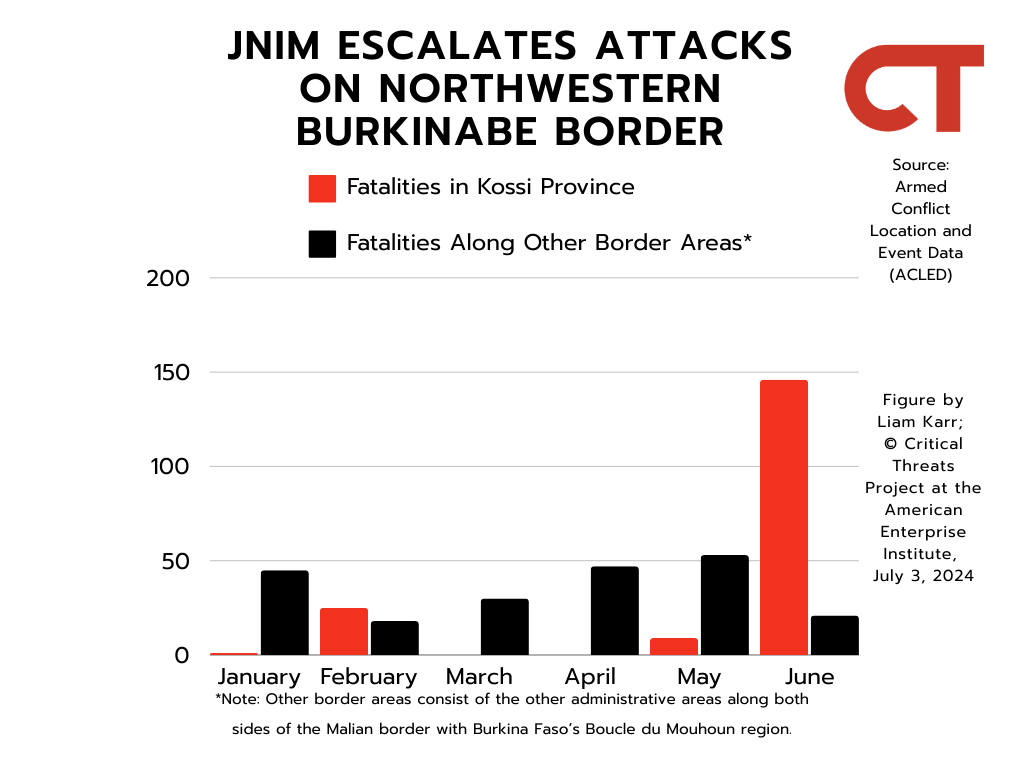
Source: Liam Karr; Armed Conflict Location and Event Data Project.
The group has also intensified attacks on civilian militias along the N3 road in northern Burkina Faso. It launched two large attacks targeting bases with formal civilian auxiliary militiamen called Volunteers for the Defense of the Homeland—or Volontaires pour la défense de la patrie (VDP) in French. The attacks are the two deadliest attacks along this stretch of the road in 2024. Greater control over the N3 would help JNIM control the area around Kaya, the capital of the Centre-Nord region. This influence would allow the group to control economic activity that comes through the city and stage attacks against military forces based there. Junta leader Ibrahim Traore commanded a unit in Kaya before launching his 2022 coup, giving the town added importance for the junta as one of its crucial support bases.[18]
JNIM likely aims to establish uncontested support in these areas by quashing VDP resistance. The VDP had increased its rate of activity in Kossi province since early May, conducting numerous ambushes on JNIM fighters moving through the area.[19] JNIM intensified the rate and severity of its attacks against civilians shortly after an ambush on June 8, indicating the subsequent attacks were in retaliation for the VDP activity.[20] The N3 attacks likely aim to further degrade the capability and will of security forces stationed in the town to conduct patrols and operations outside their bases. The targeted bases host the security forces that patrol the N3. Burkinabe forces had engaged with JNIM on more ground patrols in May and June than in the rest of 2024 combined.[21]
Figure 3. JNIM Intensifies Attacks Along the Northwestern Burkina Faso Border
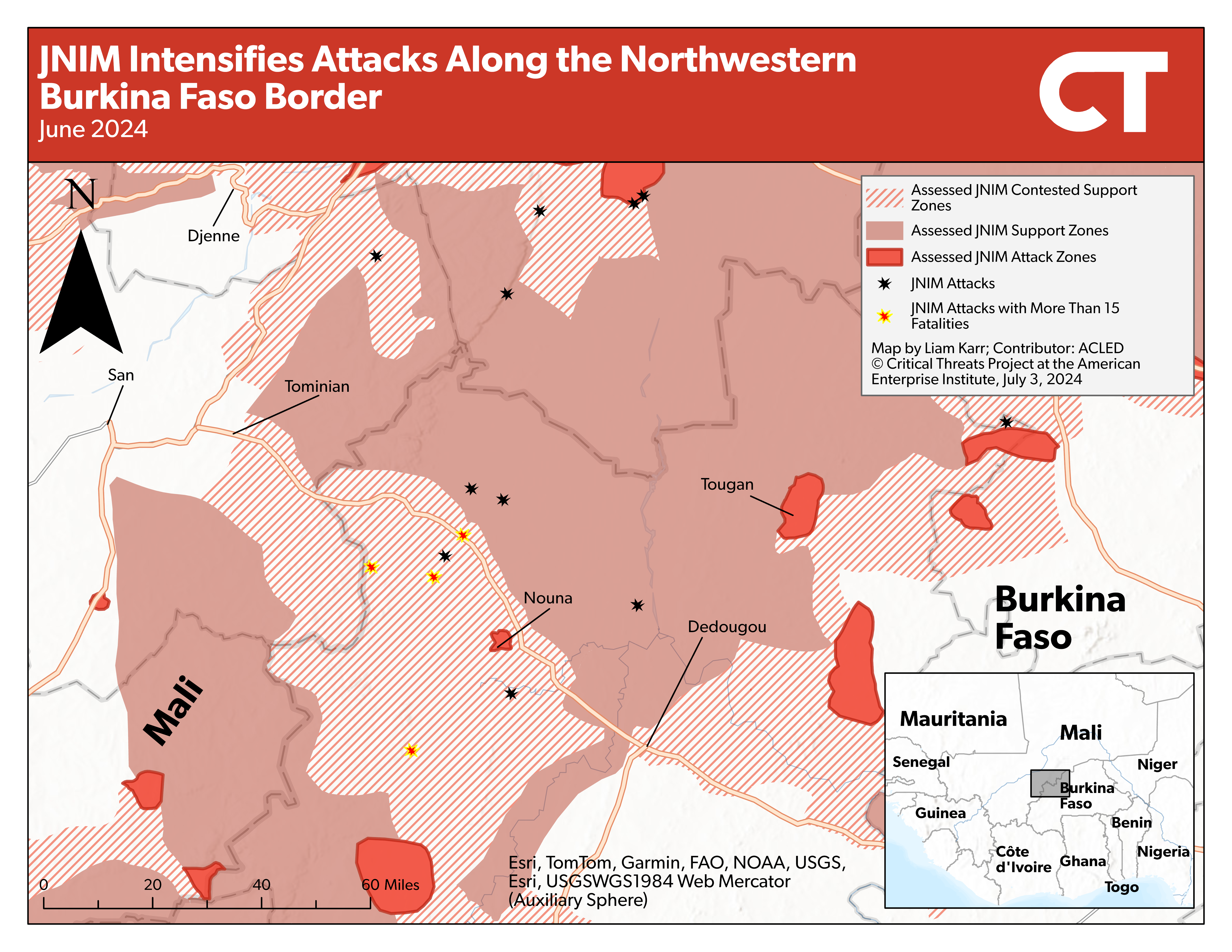
Source: Liam Karr; Armed Conflict Location and Event Data Project.
Figure 4. JNIM Intensifies Pressure on N3 Road near Kaya
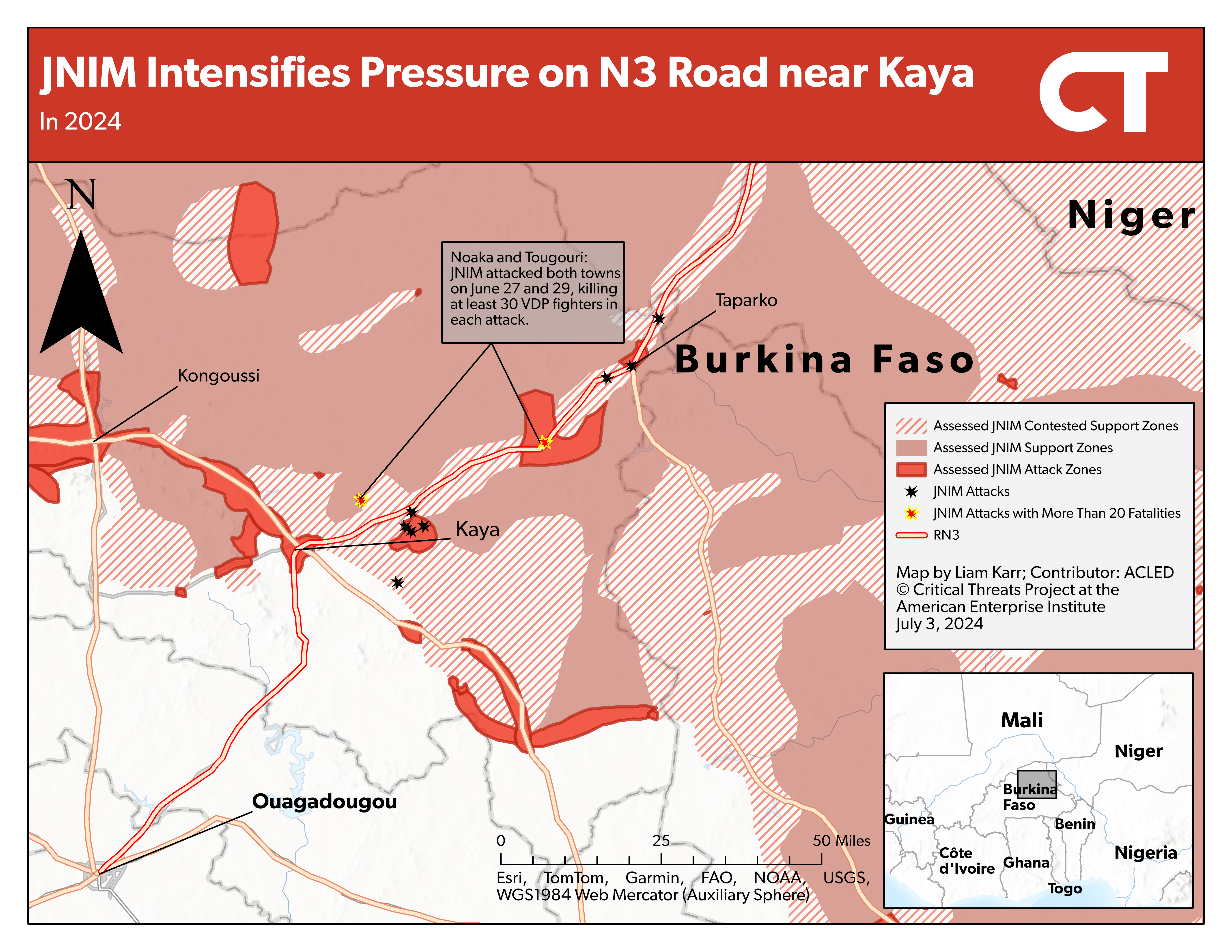
Source: Liam Karr; Armed Conflict Location and Event Data Project.
JNIM has increasingly targeted civilians since the current Burkinabe junta came into power and decided to militarize and mobilize civilians against JNIM through the VDP. Traore launched a campaign in October 2022 to recruit 50,000 civilian auxiliaries to address the Burkinabe military’s inherent manpower shortages and stem the rapidly escalating insurgency.[22] Burkinabe authorities claimed over 90,000 Burkinabe enlisted, which marked an enormous expansion on preexisting efforts that began in 2020 to mobilize civilians under the VDP.[23] VDP units participated in 269 offensive engagements in the first 18 months of Traore’s rule, compared with only 78 in the 18 months before October 2022.[24] VDP units have enabled the junta to contest JNIM in villages and areas it was previously unable to due to the limited capacity of the Burkinabe military.
JNIM has attacked VDP units more often and killed more unarmed civilians to combat the VDP’s growing role and discourage VDP mobilization. JNIM attacked lone VDP units 88 percent more often during the first 18 months of Traore’s rule compared with the previous 18 months.[25] This figure does not include attacks on VDP units that fought alongside Burkinabe army regulars. JNIM has not increased its rate of attacks against civilians in the Traore period, but attacks against civilians have become much more deadly.[26] The group killed more than twice as many civilians in the first 18 months of Traore’s rule as in the previous 18 months.[27] Retaliatory attacks against VDP-affiliated communities, such as the recent attacks in Kossi province, contribute to this significant increase.
Figure 5. JNIM Attacks on VDP, 2021–24
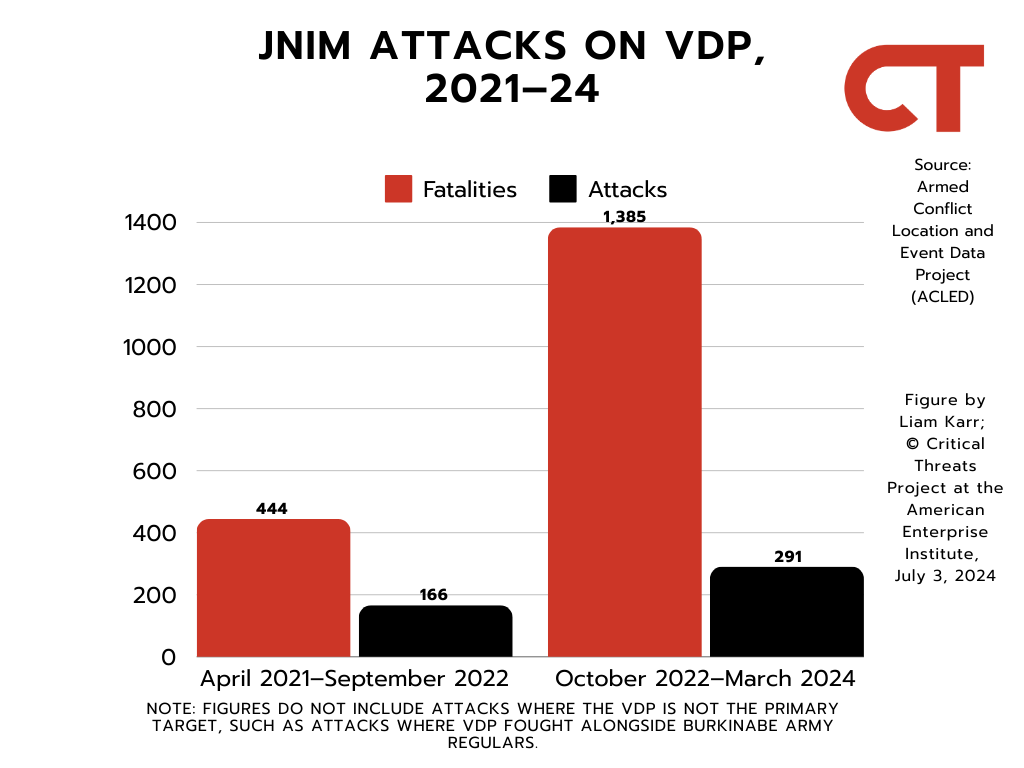
Source: Liam Karr; Armed Conflict Location and Event Data Project.
Figure 6. JNIM Attacks on Civilians, 2021–24
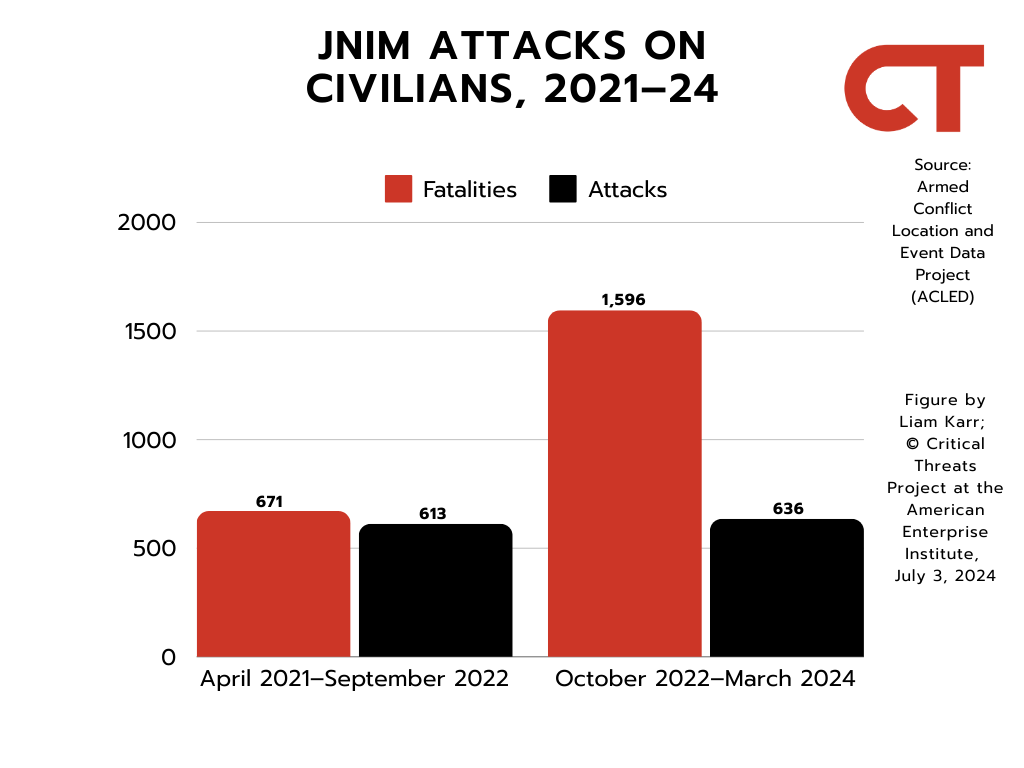
Source: Liam Karr; Armed Conflict Location and Event Data Project.
VDP units have also spread wanton violence against civilians as their role has grown. The government built the initial VDP units on preexisting self-defense militias that had mobilized since the beginning of the Salafi-jihadi insurgency in Burkina Faso in 2015.[28] This meant that the government recruited units primarily from these sedentary communities or people relatively unaffected by the insurgency.[29] Fulani communities, one of the most stigmatized and affected ethnic groups, have very few VDP members or village-level VDP forces.[30] This led to a consistent pattern of ethnically motivated VDP violence against Fulani villages that persisted before Traore’s rule.[31] However, the VDP has increased the rate and severity of its violence against civilians under Traore as its operations expand, which has continued to disproportionately affect Fulani civilians.[32] VDP and JNIM attacks on civilians due to their perceived links with the other group have further inflamed these ethnic tensions and further embedded these grievances into the ongoing insurgency.
Figure 7. VDP Attacks on Civilians, 2021–24
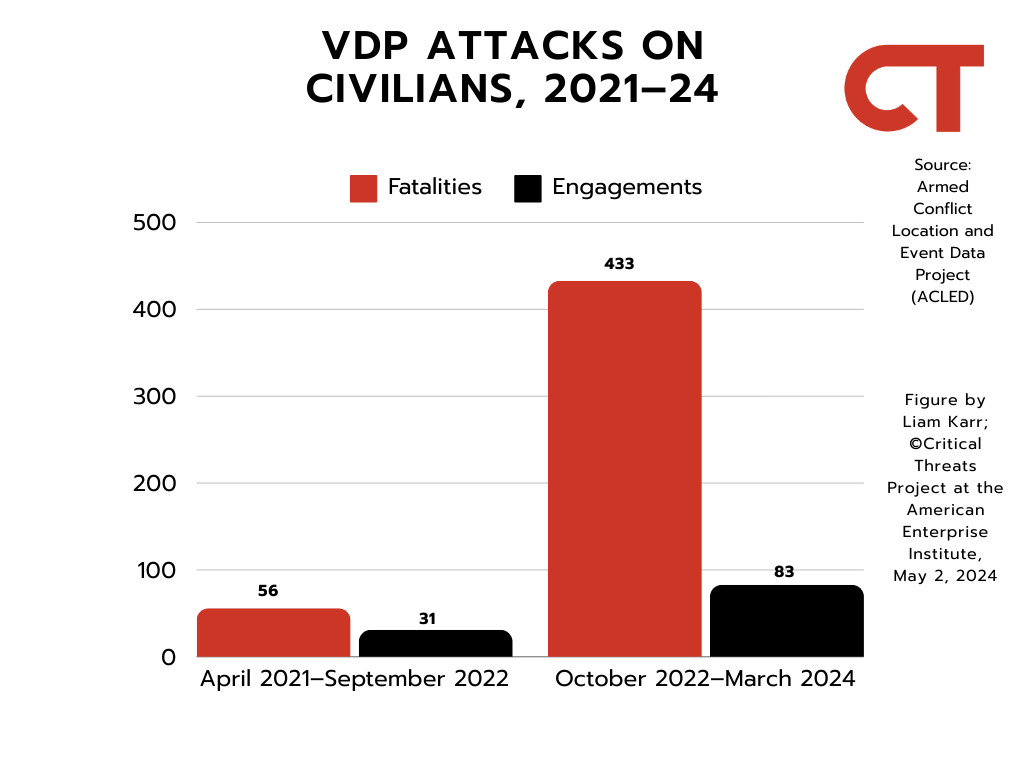
Source: Liam Karr; Armed Conflict Location and Event Data Project.
The rising toll of JNIM offensives is undermining support for the already-embattled Burkinabe junta. JNIM killed over 100 Burkinabe soldiers on June 11 in northeastern Burkina Faso in the deadliest assault since the insurgency in Burkina Faso began, in 2015.[33] CTP also reported at the end of May that JNIM increased the severity of its attacks in eastern Burkina Faso and along the Burkinabe-Nigerien border.[34] These attacks led to growing discontent among soldiers and an isolated instance of gunfire at the presidential palace in Ouagadougou, especially after the June 11 attack.[35] Traore disappeared from the public for a week afterward while his Russian and Sahelian allies sent reinforcements.[36] JNIM has continued its offensive in eastern Burkina Faso and launched an attack against an isolated town in the area on June 30 that killed at least 75 soldiers and VDPs, which further increased discontent in the army.[37]
Hundreds of civilian militia auxiliaries across northern and eastern Burkina Faso have reportedly quit since May 2024 due to high casualty rates, rights violations, withholding of salaries, and a lack of equipment.[38] Civilians in Centre-Nord also began protesting and demanding greater security after the attacks in late June.[39]
The junta has given priority to regime security in reaction to coup fears, which will likely reduce pressure on insurgent support zones and enable insurgents to continue staging large attacks. The junta mobilized the VDP and Burkinabe soldiers to safeguard against any coup plot amid the unrest in June.[40] This included redeploying several elite Rapid Intervention Battalions from their regional bases near insurgent-afflicted areas to the capital on the night of June 19.[41] These shifts decrease the frequency and effectiveness of defensive and offensive operations around the country by preoccupying security forces. JNIM and Islamic State Sahel Province conducted 29 attacks that killed 20 or more security forces and civilians in the first six months of 2024, equaling the total for all of 2023.[42] This broader trend of growing insecurity and violence will further undermine the junta’s legitimacy and stability, creating a self-feeding cycle that compounds internal instability and creates more space for insurgents.
Somalia
The ongoing transition of military bases from AU forces to Somali forces is creating opportunities for al Shabaab to exploit security gaps to attack Somali and AU forces. Al Shabaab conducted a suicide vehicle-borne improvised explosive device (SVBIED) attack on an African Union (AU) base in Beledweyne, the capital of central Somalia’s Hiraan region, on June 30. Local officials said the attack killed at least four people and wounded at least 12 others.[43] Al Shabaab claimed the attack and said it caused 29 casualties.[44] The attack occurred the same day Djiboutian troops in the African Union Transitional Mission in Somalia (ATMIS) were transitioning the base to Somali National Army (SNA) control.[45]
Al Shabaab will have the opportunity to conduct similar kinds of attacks across Somalia as the AU continues drawing down and transitioning bases to SNA forces. ATMIS is withdrawing 4,000 troops and transitioning numerous bases to Somali forces as part of phase three of its drawdown in Somalia. ATMIS has already withdrawn 5,000 troops and transitioned at least 13 bases during phases one and two of its withdrawal plan.[46] AU forces transitioned five bases to Somali forces between June 15 and July 1.[47]
Somalia and its international partners have warned that the drawdown may create gaps for al Shabaab to exploit. The Somali Federal Government (SFG) requested in May that the AU slow down and adjust the scheduled phase three ATMIS withdrawal to conclude at the end of September instead of the end of June as originally planned.[48] US Africa Command commander Gen. Michael Langley warned in late June that al Shabaab would seek to exploit any security vacuum resulting from the transition of bases from ATMIS to the SNA.[49] The AU and SFG had already published a joint assessment in March that recommended adjusting the plan for AU forces to completely withdraw from Somalia when ATMIS expires at the end of 2024 “based on the actual readiness and capabilities” of Somali forces and noted that a “hasty drawdown of ATMIS personnel will contribute to a security vacuum.”[50] This has led the SFG, AU, and international partners to discuss plans for a continued AU peacekeeping mission after the ATMIS mandate expires that will keep AU forces in Somalia. It is unclear how these plans will affect the planned ATMIS drawdown.
Al Shabaab has the capacity to launch further SVBIED attacks. Bridgeway Foundation Senior Analyst Caleb Weiss noted that al Shabaab has only conducted half as many VBIED attacks in 2024 as it had at this point in 2023.[51] However, the group’s current pace is more similar to its yearly average from 2016 to 2021.[52] This pattern indicates that the high rate in recent years was related to the central Somalia offensive in 2022 and 2023, which presented the group with more targets and cause to launch retaliatory attacks against the SFG and allied forces.
The attack also demonstrates the continued security challenges in central Somalia after the significant gains Somali forces made in 2022. Beledweyne was the initial staging ground and heart of the 2022 SFG offensive that eventually spread to the rest of central Somalia and liberated significant swaths of the country.[53] Al Shabaab reinfiltrated numerous towns around Beledweyne throughout 2023, enabling it to carry out another SVBIED attack in Beledweyne in September 2023, its first since October 2022.[54] The attack prompted SFG forces and local clan militia to clear several towns around Beledweyne, contributing to a lack of al Shabaab activity around Beledweyne since March 2024.[55] The July 1 attack demonstrates that al Shabaab still retains significant capabilities in the area despite these efforts. This comeback adds to the SFG’s growing issues in other areas of central Somalia, where US officials claim that al Shabaab has reversed all of the SFG’s 2022 gains in 2024.[56]
[1] https://apnews.com/article/boko-haram-bombing-nigeria-borno-female-suicide-e1ae2c6b0f1d86a5dffbad213b21c3d9
[2] https://humanglemedia dot com/gwoza-suicide-bombing-death-toll-rises-to-32-as-nigerias-vp-visits-hospitalised
[3] https://www.jstor.org/stable/resrep05615.7?seq=1
[4] https://www.crisisgroup.org/africa/west-africa/nigeria/b196-jas-vs-iswap-war-boko-haram-splinters
[5] https://www.crisisgroup.org/africa/west-africa/nigeria/b196-jas-vs-iswap-war-boko-haram-splinters
[6] https://www.megatrends-afrika.de/publikation/policy-brief-08-boko-haram-in-the-lake-chad-basin
[7] https://www.megatrends-afrika.de/publikation/policy-brief-08-boko-haram-in-the-lake-chad-basin
[8] https://zagazola dot org/index.php/breaking-news-edit/boko-haram-killed-35-iswap-terrorists-in-latest-rival-clashes-destroy-two-enclaves; https://zagazola dot org/index.php/breaking-news-edit/iswap-s-imam-albarnawwy-other-commanders-fled-as-boko-haram-seizes-key-bases-in-abadam; https://twitter.com/TomaszRolbiecki/status/1612370297469935616?s=20&t=HPHVFkac9iKza-AdsLjf_Q; https://www.barrons.com/articles/community-banks-economy-76e21e6a; https://www.militantwire.com/p/iswap-and-boko-haram-fighting-intensifies
[9] https://www.crisisgroup.org/africa/west-africa/nigeria/b196-jas-vs-iswap-war-boko-haram-splinters
[10] https://www.megatrends-afrika.de/publikation/policy-brief-08-boko-haram-in-the-lake-chad-basin; https://twitter.com/VincentFoucher/status/1656962896490905601?s=20; https://www.crisisgroup.org/africa/west-africa/nigeria/b196-jas-vs-iswap-war-boko-haram-splinters
[11] https://digitallibrary.un.org/record/4035877?v=pdf&ln=en
[12] https://www.crisisgroup.org/africa/west-africa/nigeria/b196-jas-vs-iswap-war-boko-haram-splinters
[13] https://digitallibrary.un.org/record/4035877?v=pdf&ln=en; https://www.megatrends-afrika.de/publikation/policy-brief-08-boko-haram-in-the-lake-chad-basin
[14] https://www.crisisgroup.org/africa/west-africa/nigeria/b196-jas-vs-iswap-war-boko-haram-splinters
[15] https://www.dw.com/en/nigerias-ex-boko-haram-fighters-weigh-return-to-conflict/a-68449555; https://www.crisisgroup.org/africa/west-africa/nigeria/b196-jas-vs-iswap-war-boko-haram-splinters
[16] https://x.com/ZagazOlaMakama/status/1690635203302080512
[17] Armed Conflict Location and Event Data (ACLED) database, available at www.acleddata.com
[18] https://www.theafricareport.com/245959/burkina-faso-ibrahim-traore-proclaimed-president-damiba-ousted
[19] ACLED database, available at www.acleddata.com
[20] https://www.facebook.com/burkinaweb.net/posts/kossiles-vdp-de-doumbala-font-la-mis%C3%A8re-aux-terroristesdans-la-nuit-du-08-au-09-/991824532952853/?locale=et_EE&_rdc=1&_rdr
[21] ACLED database, available at www.acleddata.com
[22] https://www.crisisgroup.org/africa/sahel/burkina-faso/burkina-faso/313-armer-les-civils-au-prix-de-la-cohesion-sociale
[23] https://burkina24.com/2022/11/24/recrutement-de-vdp-plus-de-90-000-inscrits; https://acleddata.com/2024/03/26/actor-profile-volunteers-for-the-defense-of-the-homeland-vdp; https://www.crisisgroup.org/africa/sahel/burkina-faso/burkina-faso/313-armer-les-civils-au-prix-de-la-cohesion-sociale
[24] ACLED database, available at www.acleddata.com
[25] ACLED database, available at www.acleddata.com
[26] ACLED database, available at www.acleddata.com
[27] ACLED database, available at www.acleddata.com
[28] https://www.clingendael.org/publication/volunteers-defense-homeland; https://acleddata.com/2024/03/26/actor-profile-volunteers-for-the-defense-of-the-homeland-vdp; https://www.crisisgroup.org/africa/sahel/burkina-faso/burkina-faso/313-armer-les-civils-au-prix-de-la-cohesion-sociale
[29] https://www.clingendael.org/publication/volunteers-defense-homeland; https://jamestown.org/program/mass-civilian-defense-force-recruitment-raises-jihadist-threat-to-civilians-in-burkina-faso; https://acleddata.com/2024/03/26/actor-profile-volunteers-for-the-defense-of-the-homeland-vdp
[30] https://www.clingendael.org/publication/volunteers-defense-homeland; https://jamestown.org/program/mass-civilian-defense-force-recruitment-raises-jihadist-threat-to-civilians-in-burkina-faso
[31] https://www.clingendael.org/publication/volunteers-defense-homeland; https://www.crisisgroup.org/africa/sahel/burkina-faso/burkina-faso/313-armer-les-civils-au-prix-de-la-cohesion-sociale; https://acleddata.com/2024/03/26/actor-profile-volunteers-for-the-defense-of-the-homeland-vdp
[32] https://acleddata.com/2024/03/26/actor-profile-volunteers-for-the-defense-of-the-homeland-vdp
[33] https://www.jeuneafrique.com/1578154/politique/au-burkina-faso-une-hecatombe-pour-larmee-a-mansila
[34] https://www.criticalthreats.org/analysis/africa-file-may-31-2024-russian-red-sea-logistics-center-in-sudan-jnim-strengthens-along-the-burkinabe-nigerien-border#Sahel
[35] https://www.lemonde.fr/afrique/article/2024/06/19/au-burkina-faso-la-grogne-des-soldats-s-amplifie-contre-le-regime-militaire_6241373_3212.html
[36] https://www.rfi.fr/fr/afrique/20240618-burkina-faso-des-soldats-maliens-et-des-mercenaires-russes-de-wagner-sont-arriv%C3%A9s-%C3%A0-ouagadougou
[37] https://x.com/lsiafrica/status/1808411090683932673
[38] https://x.com/AgRhissa2/status/1797974032392048860; https://www.france24.com/fr/afrique/20240527-burkina-faso-vdp-volontaires-pour-la-d%C3%A9fense-de-la-patrie-d%C3%A9posent-les-armes
[39] https://x.com/Wamaps_news/status/1807788378487755224
[40] https://www.rfi.fr/fr/afrique/20240614-burkina-faso-incertitudes-apr%C3%A8s-un-tir-d-obus-ce-mercredi-les-soldats-appel%C3%A9s-%C3%A0-regagner-leur-d%C3%A9tachement
[41] https://x.com/AgRhissa2/status/1803688347530850505; https://x.com/SahelLeaks/status/1803761331054473540
[42] ACLED database, available at www.acleddata.com
[43] https://thesomalidigest dot com/al-shabab-launches-svbied-attack-on-atmis-base-in-beledweyne
[44] SITE Intelligence Group, “Shabaab Claims Suicide Bombing at SNA Base in Beledweyne, Reports 29 Casualties as Initial Outcome,” June 30, 2024, available by subscription at www.siteintegroup.com
[45] https://atmis-au.org/atmis-hands-over-orhasan-military-base-to-somali-national-armed-forces
[46] https://reliefweb.int/report/somalia/sector-commanders-discuss-somalia-security-ahead-next-stage-atmis-drawdown
[47] https://atmis-au.org/atmis-hands-over-orhasan-military-base-to-somali-national-armed-forces; https://atmis-au.org/atmis-kickstarts-third-phase-of-troop-drawdown
[48] https://www.reuters.com/world/africa/somalia-asks-peacekeepers-slow-withdrawal-fears-islamist-resurgence-2024-06-20
[49] https://nation.africa/kenya/news/africa/how-somali-can-avoid-an-al-shabaab-takeover-4673708
[50] https://www.reuters.com/world/africa/somalia-asks-peacekeepers-slow-withdrawal-fears-islamist-resurgence-2024-06-20
[51] https://www.fdd.org/analysis/op_eds/2024/07/01/shabaab-hits-djibouti-military-base-with-suicide-bombing-in-central-somalia
[52] https://www.fdd.org/analysis/op_eds/2024/07/01/shabaab-hits-djibouti-military-base-with-suicide-bombing-in-central-somalia
[53] https://www.criticalthreats.org/briefs/africa-file/africa-file-clan-uprising-bolsters-anti-al-shabaab-offensive-in-central-somalia; https://www.crisisgroup.org/africa/horn-africa/somalia/b187-sustaining-gains-somalias-offensive-against-al-shabaab
[54] https://apnews.com/article/somalia-checkpoint-bombing-477aa77d10056fab5fae756bf0ca3869
[55] ACLED database, available at www.acleddata.com
[56] https://www.voanews.com/a/al-shabab-reverses-somali-force-gains-is-working-with-houthis-in-somalia-/7659656.html
